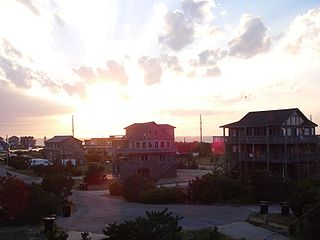
Avon is an unincorporated community and census-designated place (CDP) in Dare County in the U.S. state of North Carolina. As of the 2010 census, it had a permanent population of 776.

Duck is a town in Dare County, North Carolina, United States. As of the 2020 census, the population was 746. During the peak vacation season, starting after Memorial Day, the population increases to over 20,000. Duck is the northernmost incorporated town in Dare County and the Outer Banks' newest town, incorporated on May 1, 2002. Duck offers visitors outdoor recreational activities, summer events and concerts, watersports, fine dining, shopping, art galleries, and a nationally known jazz festival, as well as the 11-acre (4.5 ha) Town Park and soundside boardwalk.
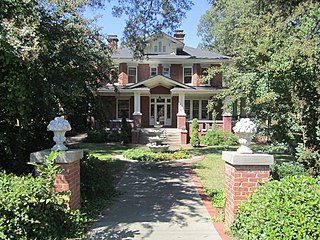
The George and Neva Barbee House, also known as the Dr. G. S. Barbee House, is a historic home located at Zebulon, Wake County, North Carolina, a town near Raleigh, NC. Constructed in 1914, the two-story, brick American Foursquare house was designed in the American Craftsman / Bungalow style. It features a hipped roof with overhanging eaves, a porte cochere, a sheltered wraparound porch, and a nearly solid brick porch balustrade.

North Manitou Island Lifesaving Station, also known as North Manitou Coast Guard Station, is a complex of buildings located on North Manitou Island, which is part of Sleeping Bear Dunes National Lakeshore in Michigan, in the U.S. The complex was constructed as a life-saving station. It is the only remaining station which was in use during all three periods of lifesaving service history, from the early volunteer period through operation by the United States Life-Saving Service and the United States Coast Guard. It was declared a National Historic Landmark in 1998.

The Bodie Island Lifesaving Station, also known as the Bodie Island Coast Guard Station, is located on the Outer Banks of North Carolina at the southern end of Bodie Island, within Cape Hatteras National Seashore. The 10-acre (4.0 ha) district includes a residence, the lifesaving station, the Coast Guard station, and an observation tower, as well as a number of utility buildings. The facility was turned over to the National Park Service in 1953, with the establishment of the national seashore. The primary structure, the lifesaving station, was built in 1878, and was converted to a residence when the Coast Guard station was built in 1925. It was moved to its present location in 1955, as it was threatened by shoreline erosion. The Coast Guard station was altered the same year to provide housing and office space for the National Park Service.

The Tarboro Cotton Press, which is also called the Norfleet Cotton Press or the Edgecombe County Cotton Press, is a wooden cotton press built in the mid-18th century in Edgecombe County, North Carolina. It was moved to the Tarboro Town Common of Tarboro, North Carolina. It was named to the National Register of Historic Places on February 18, 1971. It is located in the Tarboro Historic District.

The Eagle Harbor Coast Guard Station Boathouse is a boathouse located at 9282 Marina Road in Eagle Harbor, Michigan. It was listed on the National Register of Historic Places in 2012.

The Nahant Life-Saving Station is a historic coastal rescue station in Nahant, Massachusetts. The station, which consists of a residence and an equipment building, was established in 1900 by the United States Life-Saving Service before being taken over by the United States Coast Guard in 1915. The station was discontinued in 1964, and the facilities were converted recreational use by the Coast Guard. In 1999 the 1.4 acres (0.57 ha) parcel was turned over to the Town of Nahant. The station, one of twelve such surviving facilities in the state, was listed on the National Register of Historic Places in 2012.
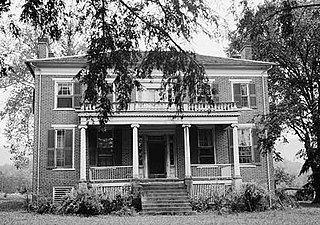
Clover Hill, also known as the Colonel Edmond Jones House, is a historic plantation house located near Patterson, Caldwell County, North Carolina. It was built in 1846, and is a two-story, five bay, brick, Greek Revival-style house. It sits on a raised basement and has a hipped roof. It features a shed porch surmounted supported by four handsome fluted Ionic order columns.

Central Elementary School is a pair of historic school buildings in New Bern, Craven County, North Carolina. The First New Bern Academy is located on New Street and was built about 1806. It is a two-story, brick building with a hipped roof and two interior ridge chimneys. It features a semicircular tetrastyle entrance porch with Tuscan order columns and a roof cupola. It has a rear addition dated to the late-19th century. The Second New Bern Academy was built in 1884 to replace the previous building. The buildings retained their educational functions until 1971. The 1806 building now houses a museum, while the 1884 building has been converted into apartments.
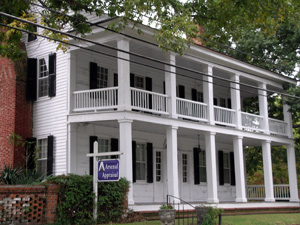
Cool Spring Place, also known as Cool Spring Tavern, is a historic home located at Fayetteville, Cumberland County, North Carolina. It was built in 1788, and is a two-story, five bay by four bay, rectangular Federal style frame dwelling. It low hipped roof and features a double porch on the front facade. It operated as a tavern until 1795, and is believed to be the oldest existing structure in the city of Fayetteville, having survived the disastrous fire of 1831.
Oregon Inlet Station is a historic lifesaving station located near Rodanthe, Dare County, North Carolina. It was built in 1897 by the United States Life-Saving Service and remodeled in 1933 and 1970. It is a 1 1/2-story, Shingle Style rectangular frame building with a lookout tower. It has a porch that surrounds the building. It was one of seven lifesaving stations established on the Outer Banks of North Carolina in 1874, to serve the ships that were lost in the treacherous waters off the North Carolina coast.
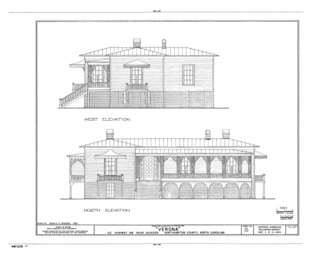
Verona is a historic plantation house located near Jackson, Northampton County, North Carolina. It was built about 1855, and is a one-story, six bay, "T"-shaped, Italian Villa style frame dwelling. It has a hipped roof, is sheathed in weatherboard, and sits on a brick basement. It features a full-width porch, with flat sawnwork posts and delicate openwork brackets. Also on the property is the contributing family cemetery. The house was built for Matt Whitaker Ransom (1826-1904), Confederate brigadier general, United States senator, and minister to Mexico, and his wife Martha Exum.

Eagle Lodge is a historic Masonic lodge building located at Hillsborough, Orange County, North Carolina. It was built in 1823, and two-story, three bay, square brick building in the Greek Revival style. It has a low hipped roof with heavy box cornice and a one-story pedimented porch with Ionic order columns.

Dr. Arch Jordan House, also known as the manse for Little River Presbyterian Church, is a historic home located near Caldwell, Orange County, North Carolina. It was built about 1875, and is a two-story, single pile, central hall plan, Italianate style frame dwelling. It features a central projecting gable, bracketed eaves, and a columned porch with a low hipped roof. Attached at the rear is an originally-separate two-story kitchen building. Also on the property are the contributing combination smokehouse/food storage shed, log and weatherboard tobacco barn, and 1+1⁄2-story main barn.

Sutton-Newby House is a historic plantation house located near Hertford, Perquimans County, North Carolina. It was built about 1745, and is a 1+1⁄2-story, four bay, frame dwelling with a brick end and gable roof. It originally had both ends in brick. It features a full-width, shed roofed front porch and massive double shouldered chimney. It is a member of the small group of 18th century frame houses with brick ends in northeast North Carolina; the group includes the Myers-White House and the Old Brick House.
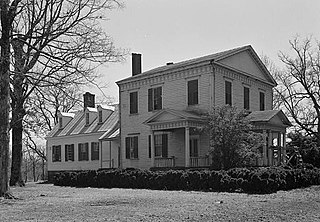
Elgin is a historic plantation house located near Warrenton, Warren County, North Carolina. It was built about 1835, and is a two-story, three bay, Federal style temple-form frame dwelling. It has a gable roof, pedimented front porch, and flanking porches. At the rear is an earlier 1+1⁄2-story frame dwelling with a gable roof. The front facade features a Palladian entrance with sidelights and Tuscan colonnettes. The house is similar in style to Dalkeith.
The Whitehead Lifesaving Station was a maritime rescue facility on Whitehead Island, an island off the coast of St. George, Maine at the mouth of Penobscot Bay. Established in 1874 by the United States Life-Saving Service, its original building is one of the best-preserved of the five stations built by the service on the coast of Maine and New Hampshire at that time. The station was in active use until the 1940s, and is now privately owned. It was listed on the National Register of Historic Places in 1988.

The Ocean City Life-Saving Station is the only life-saving station of its design in New Jersey still in existence. Designed by architect James Lake Parkinson in a Carpenter Gothic style, the building is one of 25 stations built of the 1882 life-saving type. It is also one of six still in existence in the country. Construction on the facility began in September 1885 and was completed in the following year. There were two earlier stations in the northern end of Ocean City before this facility was constructed, and there were two stations farther south on the island.

Kitty Hawk Life-Saving Station was a life-saving station on Kitty Hawk, on the Outer Banks of North Carolina. It was built in 1874 and put in service until 1946. The building is registered with National Register of Historic Places since October 11, 1984.





















